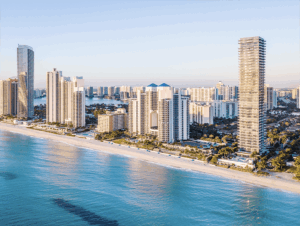New York City is dramatically outpacing the rest of America’s commercial real estate recovery, as companies snap up prime space at levels not seen since 2006.
Manhattan’s office market has staged a remarkable comeback that’s leaving other major U.S. cities scrambling to keep pace. Through the first three quarters of 2025, businesses have committed to 23.2 million square feet of additional office space in the borough—the strongest nine-month performance in 19 years, according to commercial real estate giant CBRE Group.
The resurgence marks a dramatic reversal of fortune for a market that seemed destined for prolonged decline just years ago. While office markets nationwide continue struggling to regain their footing, Manhattan has not only recovered but exceeded its pre-pandemic leasing velocity. The numbers tell a striking story: Manhattan’s 2025 activity has already surpassed 2018-2019 levels, while national office leasing remains mired roughly 11% below pre-pandemic benchmarks.
The Forces Driving New York’s Ascent
Several converging trends are propelling Manhattan’s office renaissance. The city’s return-to-office rates lead the nation—by July, office attendance had climbed 1.3% above July 2019 levels, according to data from Placer.ai. That performance stands in sharp contrast to the national picture, where workplace attendance remains 22% below 2019 levels.
Wall Street’s continued dominance plays a crucial role. Major financial institutions are expanding headcount to capitalize on surging dealmaking activity and a revitalized IPO market, even as broader economic indicators suggest deceleration. The sector’s appetite for premium, modern workspace shows no signs of abating.
The professional services industry is equally hungry for space. Deloitte captured headlines with one of the year’s marquee transactions, signing a lease for nearly three-quarters of a Hudson Yards tower currently under construction on Manhattan’s West Side.
Technology and media companies continue their Manhattan expansion that began in recent years. Amazon exemplifies this trend, purchasing a Fifth Avenue property and leasing an additional 330,000 square feet to deepen its New York footprint.
Premium Space Creates Landlord’s Market
Demand for top-tier Manhattan properties has intensified to the point where major tenants increasingly face an uncomfortable choice: secure a prestigious address or lock down a state-of-the-art building—but rarely both simultaneously.
“In most other cities, landlords only wish they had that kind of problem,” observes Michael Slattery, CBRE’s research director for the New York region.
The competition has emboldened developers. More than half a dozen new office projects are advancing across Manhattan—the most ambitious construction pipeline since the pandemic began. Their confidence stems from concrete evidence: a record 143 leases have been executed through September 2025 at rates exceeding $100 per square foot, already surpassing the full-year 2024 total at that premium threshold.
JPMorgan Chase’s recently unveiled Park Avenue headquarters exemplifies the new standard. The $3 billion, 60-story tower features 19 food vendors, outdoor garden spaces, and meditation rooms—amenities that were considered extravagant just a decade ago.
“Other corporations and their clients and employees are going to want a more comparable experience,” says Owen Thomas, chief executive of office developer BXP. “It’s elevating the expectation of what an office can be.”
BXP appears poised to capitalize on these elevated expectations. The firm has reportedly reached a preliminary agreement to lease one-third of its under-construction Midtown development to C.V. Starr & Co., the global insurance and investment firm, according to sources familiar with the negotiations. Thomas declined to comment on the reported deal.
New York’s Unique Advantages
Manhattan offers structural benefits that competing markets struggle to match. The city’s business corridors—from the Financial District to the Park Avenue spine near Grand Central Terminal—provide suburban professionals with relatively straightforward train commutes, a luxury in an era when convenience heavily influences workplace decisions.
Demographics further tilt in New York’s favor. The city ranks first among U.S. metropolitan areas for attracting newly minted college graduates, according to JLL research analyzing nearly 1.5 million recent graduates entering office employment. For companies competing for young talent, New York’s appeal proves difficult to resist.
“Early in the pandemic, New York was among the lagging group of gateway markets,” notes Jacob Rowden, JLL’s senior manager of U.S. office research. “But in late 2021 and early 2022 that narrative started to shift.”
Challenges Persist Despite Momentum
The recovery remains incomplete. Manhattan’s vacancy rate stands at 14.8%, according to CoStar—nearly double the 8.2% recorded in late 2019. Numerous aging, undistinguished properties face obsolescence or financial distress, creating a bifurcated market where premium assets thrive while struggling buildings languish.
Interestingly, even secondary properties are showing signs of life. Class B buildings have recovered approximately 10% of the 25 million square feet they shed during the pandemic—a recovery rate five times faster than comparable properties nationally, CoStar data indicates.
The industry also confronts political uncertainty. Next month’s mayoral election looms large, with democratic socialist candidate Zohran Mamdani expected to win. His platform—including rent freezes on rent-stabilized apartments and increased taxation on high earners—has triggered anxiety among real estate executives.
“What could disrupt [New York’s] recovery would be if we had an unwelcome climate for business and entrepreneurs,” warns developer Gary Barnett.
Yet Barnett’s actions suggest confidence in the market’s fundamentals. He’s currently developing a new office building near Grand Central Terminal that has already secured IKEA as an anchor retail tenant.
Reimagining Obsolete Properties
Manhattan is experiencing one of its most active periods of office-to-residential conversions since World War II, driven by favorable city and state policies. The transformation addresses both the glut of outdated office space and the perpetual need for housing in America’s most expensive city.
“Every neighborhood in New York is becoming a mixed-use neighborhood,” says developer Marty Burger, whose group is converting a tower near the Empire State Building into residential units.
This adaptive reuse strategy may prove crucial for Manhattan’s long-term vitality, allowing the market to shed obsolete inventory while creating housing stock that could help moderate the city’s notorious cost of living. As New York’s office market continues outperforming the nation, this dual transformation—premium space soaring while troubled assets find new purpose—may define the next chapter of Manhattan’s commercial real estate story.
Source: WSJ



